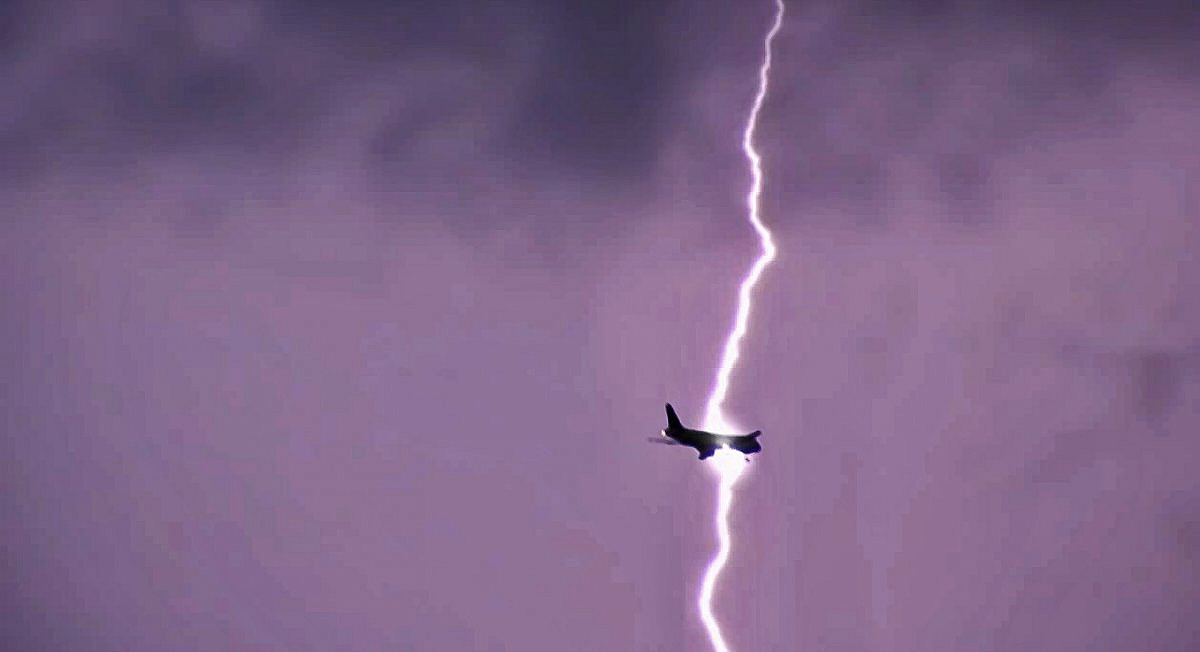One working theory around the crash landing of the Aeroflot Sukhoi Superjet-100 that killed 41 in Moscow last week is that lighting struck the aircraft, causing significant damage. I asked LALF reader 121Pilot, a U.S. commercial airline pilot, if lightning can truly make a jetliner crash.
Matthew asked me to address the subject of lightning protection in light of the Aeroflot SuperJet accident in Moscow last week. What you should know is that airliners are required to be capable of sustaining a lightning strike without loss of essential systems.
Lightning strikes on airliners are rare but not unknown. Usually what you get is a bright flash and a loud bang followed by…nothing. Everything keeps running just like it did before the strike. Upon landing the maintenance inspection will usually reveal small burn holes were the strike impacted and then departed the airplane but that’s it. Composites, unlike metals, don’t conduct electricity so they present a thornier problem. Composite control surfaces have had sizeable chunks blown off in the past by lightning strikes, though never enough to create control difficulties.
Have you ever noticed that when you board a 787 your cell phone loses its signal? That’s because the metal mesh embedded into the fuselage skin on the 787 acts like a Faraday cage blocking signals from getting through the skin. That mesh is there so that in the event a 787 is hit by lightning there is a conductive path through the airplane like what you would find with one with its frame built out of aluminum. So, no a lightning strike should not cause a loss of essential systems and its not something that is a serious cause for concern.That it did reportedly cause problems on the SSJ100 is well outside what normally happens.
However, in the wake of what happened in Moscow it seems like a good idea to talk about what you as a passenger can do to stack the deck in your favor should things ever go wrong. Let’s be honest: given the accident rate these days, the odds of anyone reading this blog ever being involved in an aircraft accident are exceedingly remote…just like the odds of my experiencing an engine failure. In over 20 plus years of flying airliners it has yet to happen to me.
But it’s something we all still take very seriously. Every takeoff we brief what actions we will take in the event it should happen. And all the details of getting the airplane into the air are planned with that assumption in mind. Takeoffs and landings are my favorite part of the job but the period in the takeoff from 80 knots (beyond which we will only abort for major failures) to V1 (the speed beyond which you are committed to flying no matter what) is unquestionably the most stressful part of the flight. Because in the high-speed regime on the ground the margins for error are much smaller. During that time period I am absolutely laser-focused because I know that should the worst happen safety depends on my being on my A game. As I said, it has been that way for over 20 years even though it’s never happened and hopefully never will.
So just like we in the cockpit plan for the worst and hope for the best, let me encourage you sitting behind the door to do the same.
Four Tips On Being Prepared For The Worst
First the most important asset you have should things go wrong is a clear head. Stay calm, think clearly, and do not panic. If you’re going to have to evacuate an airliner then time is your enemy. As we saw in Moscow, seconds can and do matter which means leaving everything behind. Do not, under any circumstances, stop to pull bags from the overhead bins. I repeat, leave everything and focus on getting off the airplane as quickly and calmly as possible. That time you spend trying to claim your belongings could very well cost you, or worse, someone else their life. Given the situation they faced in Moscow, its almost certain that people did die because those in front of them paused to claim their bags. If there are items (wallet, passport, phone, etc) that you feel you simply cannot be without, then keep them on your person for takeoff and landing.
Second, let’s talk about footwear. Should the worst happen its possible that you could be evacuating an aircraft on fire or one that has broken up to some degree. So when you fly, wear closed toe shoes. No sandals, no crocs, no slippers, etc. You want footwear that you know will stay on your feet and provide decent protection. Also, if your flying in a premium cabin let me encourage you to keep your street clothes on until you’re in the air. Should the worst occur, airline PJ’s and slippers are not the attire you want on. Once your airborne by all means change and get comfy. But wait until your airborne (I’m talking to you Matthew!).
Third, be aware of your emergency exit options and how to use them. In most airplanes you will always have the option to go forward or aft. If you’re the one seated in an emergency exit row in an accident look out the window before you open it. If you see a raging fire outside then you clearly don’t want to open the exit. Again, keeping a calm clear head is your best friend at this point. One of the components of certifying an airliner is a demonstrated ability to get everyone off in 90 seconds using only half the exits. So, whether big or small, know that you can indeed be off the plane very quickly in an emergency.
Fourth, my last piece of advice to always keep your seat belt on. Unexpected clear air turbulence is rare but it does happen. In every case where people have been injured, the ones hurt have been those not strapped in. So please, keep your seat belt firmly fastened whenever you’re in your seat.
CONCLUSION
It bears repeating that the odds are you will never need any of this advice. Day in and day out for over 20 years I’ve never even been close to needing it myself. But sometimes things do go wrong and the worst does happen. So, when you fly make sure you’ve stacked the deck in your favor.
> Read More:41 Killed in Aeroflot Crash
image: Screen shot via weweme123 on YouTube





“Do not, under any circumstances, stop to pull bags from the overhead bins.”
Time and again we see people not heeding this advice. It’s a shame. Over the weekend, in Burma, a plane landed without its nose gear deploying and we saw people do the same thing.
https://www.bbc.com/news/world-asia-48245203
I’ve said this before, and I’ll say it again. The only way to stop people from doing that is removing overhead bins altogether.
Or locking them on takeoff.
Great advice.
Nice read. Even after years of flying and being on planes a few times a week I do not let complacency take me away from one important ritual: Count the rows to the exits both forward and aft so that I can count by feel if needed during an evacuation. Takes two seconds and then I go back to my iPad.
I always keep me and my wife’s passport in my jean pocket during takeoff and landing, just in case the need for an emergency evacuation arises.
If an emergency evacuation from an aircraft occurs in an international airport, having your documents handy I imagine will be useful! Happened to my father-in-law once, and they separated those with documents from those without… those without had to wait in a sterile area before immigration, whereas those with documents could be cleared into the transit area. He luckily had his passport with him in his pocket.
Thanks for this! I am a frequent flyer and only once was the aircraft I was flying in hit by lightning. It was an Eastern Airlines DC 9 on our way to Detroit. Captain came on and explained what had happened
One thing I wondered about is why American carriers do not require all window shades to be open during landings and takeoffs- especially shades on emergency exits. Some European carriers insist on open shades so that people can be aware of what’s outside should they need to exit the aircraft.